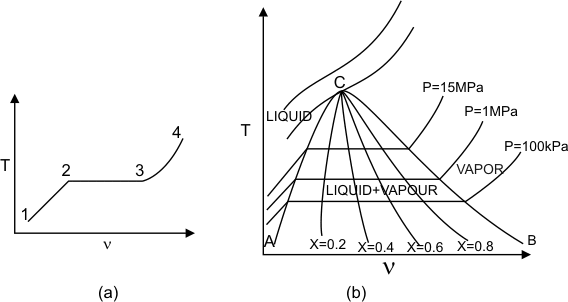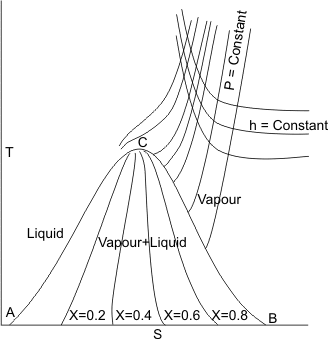(c)  Diagram Diagram
Refer to  diagram shown in Fig 11.3. Let us consider constant pressure heating of liquid water in a cylinder-piston assembly. If the water is initially at state 1, on heating at constant pressure, the temperature and the specific volume of the water increase and follows the path 1-2 as shown in Fig 11.3(a). diagram shown in Fig 11.3. Let us consider constant pressure heating of liquid water in a cylinder-piston assembly. If the water is initially at state 1, on heating at constant pressure, the temperature and the specific volume of the water increase and follows the path 1-2 as shown in Fig 11.3(a).

Figure 11.3
At point 2 vaporization starts. The vaporization process is represented by 2-3. During vaporization, temperature and pressure remain constant. The point 3 represents saturated vapour. Further heating produces super heated vapour, that is vapour above its saturation temperature at the specified pressure. If the constant pressure heating is done at several different pressures, the resulting temperature-volume diagram becomes as it is shown in Fig 11.3 (b). The curve AC represents saturated liquid line and the curve BC represents the saturated vapour line.
(d) T-s diagram
Let us refer to the T-s diagram shown in Figure 11.4

Figure 11.4
(e) Enthalopy-entropy diagram or Mollier diagram.
Refer to figure 11.5 which is known as h-s diagram.

- Heat interaction in an isobaric process is equal to change in enthalpy of the system.
- For a flow process (will be discussed later) the work done by an adiabatic device is equal to the decrease in enthalpy of the flowing fluid.
- A throttling process is an isenthalpic process. A throttling process is a process in which a fluid flows from a region of high pressure to a region of low pressure without exchanging energy as heat or work.
- A reversible adiabatic process is an isentropic process.
|